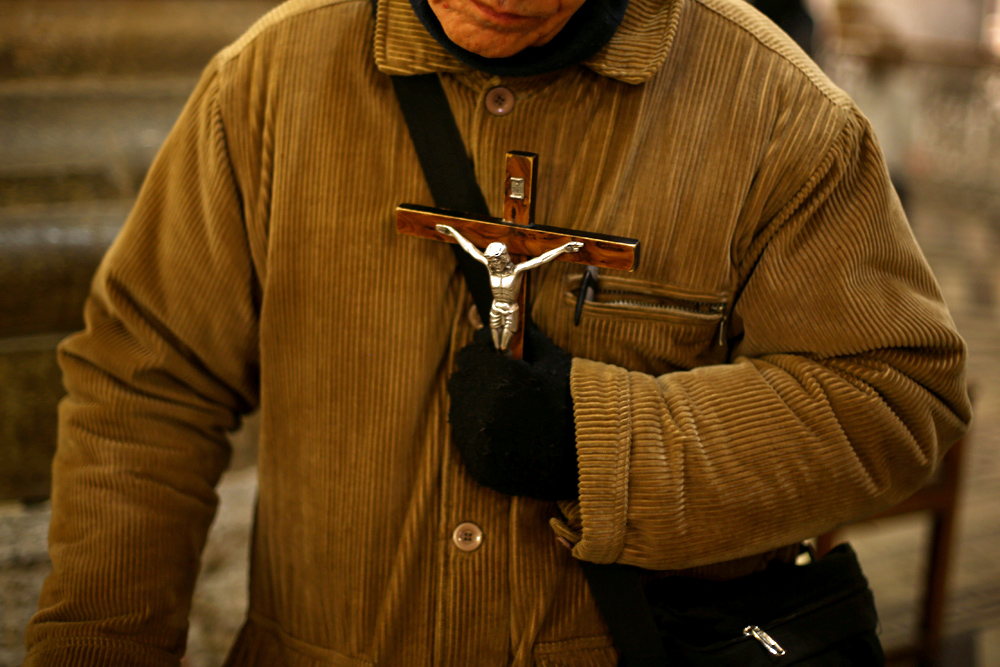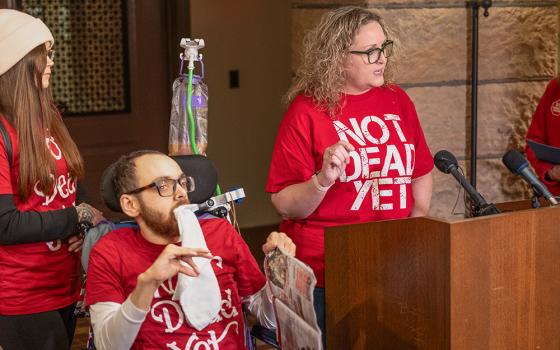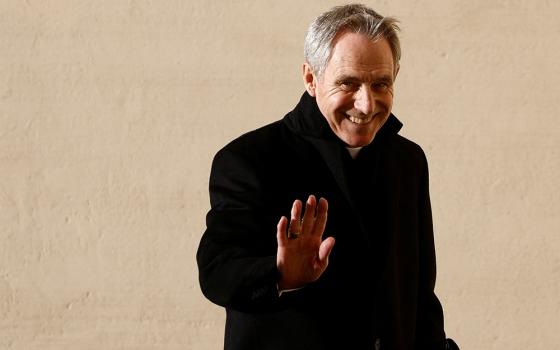
A man holds a crucifix May 18, 2018, in Santiago, Chile. (CNS/Ivan Alvarado, Reuters)
After reading James Carroll's lengthy lament in The Atlantic on the corruption in the Catholic Church and its priestly caste, I remembered reading an article in America magazine by the late Jesuit theologian Walter Burghardt.
"In the course of half a century," the weathered scholar wrote in Tell the Next Generation, "I have seen more Catholic corruption than you have read of. I have tasted it. I have been reasonably corrupt myself. And yet I joy in this Church — this living, pulsing, sinning people of God."
Carroll admits to an ocean of grief from the corruption now painfully evident in the church, not the church understood as the people of God, but the hierarchical church. His grief is oceans away from what we might term reasonable, from the mostly petty corruptions of people like Burghardt and the rest of us. The corruption that so saddens Carroll is mortally grave because, as he sees it, the toxic clericalism at its roots has over centuries embedded itself in the very structure, the very bones, of the hierarchical, institutional church. As such, he no longer looks for reform from church leaders found to be at the very center of the corruption.
I met Carroll over 50 years ago when we were both young priests. We are friends who view the dark side of the church and priesthood through the same lens. I've been nourished by his poetry and novels, informed by his historical works, challenged by his commentaries as a columnist and essayist, and moved by his memoir, An American Requiem. Carroll has named for me what continues to unsettle my soul — the superior status and lofty identity the church claims for its priests, cultivated and sustained by clerical celibacy and the withholding of meaningful leadership roles from the laity, especially women. But beyond touching into my personal struggle to find some semblance of integrity in a morally and structurally flawed church, Carroll's analysis of its present dark night of scandal is painfully incisive and compelling.
Immediately after the publication of his Atlantic essay, however, his prescription — or treatment plan — for the reform and renewal of his diseased and corrupted church drew fire, both from conservative and progressive Catholics. Carroll, I suspect, may simply be a step ahead of us.
He has cut through the cloud of denial and minimization, the "willed ignorance," that has paralyzed many of the Catholic bishops from taking the kind of action that would have stemmed the tragic, secret abuse of our young. At the same time, Carroll has rocked the complacency of many priests and laity who simply prefer not to think of the church's now bared failures and sins. In spite of his sharp criticism of Pope Francis, Carroll stands with the pope in linking the crimes of priest and bishop predators to a corrupted clerical culture, to a sick system of privilege and status and secrecy. Held in the spotlight of realities we no longer can deny, we begin to see, imperfectly no doubt, the unmeasured harm inflicted on thousands of children and vulnerable adults by some clergy, both high and low.
With a lump in his throat, Carroll reports he can no longer remain even at the far edges of his church. In a decisive turn triggered by Francis, he has chosen to fast from Mass and to forgo the status of what was known in past years as a "practicing Catholic." He is saying to his fellow Catholics, if your integrity requires you to step back from the institutional church and fast from the holy Communion of your parish, heed the voice of your conscience. Yes, step back, he urges, from "the cassock-ridden power structure of the Church and reclaim Vatican II's insistence that the power structure is not the Church."
Carroll is right to remind Catholics that the church is not essentially the hierarchy or its organizational apparatus. "It is a community of memory, keeping alive the story of Jesus Christ." The church's ordained ministers and its structures and social systems are meant to sustain that memory which remains the church's foundation. That is why I believe Carroll remains a Catholic to his core.
Both Carroll and I heard in our seminary years the Latin proverb "Corruptio optimi pessima," the corruption of the best is the worst. And both Carroll and I have seen the best of the church. We have seen the everyday goodness, generosity and perseverance of the people we have served. We have ministered alongside good priests and have known humble bishops. We have been inspired by the selfless commitment of religious sisters to the poor and needy. We have deep respect for underpaid and often unappreciated lay ecclesial ministers.
Advertisement
Aware of this goodness, the corrupt strands knotted in the very center of the institutional Catholic Church are painful to acknowledge and difficult to confront. For us and for many others, it is indeed the corruption of the best. Carroll and I also learned that the church is "simul justus et peccator" — both saint and sinner. Both whole (holy) and corrupt. And now and always in need of renewal and reform.
So I search for a calculus of corruption. Like Burghardt, I am aware of my own reasonable, I hope, corruption. And I understand that all things finite sooner or later encounter some form of corruption, some form of death. I also understand that governments, justice systems, corporations and educational systems are never without their own often hidden currents of corruption.
Yes, social sin and structural, systemic corruption abound. But the kind of moral perversity that harms the young or vulnerable deserves no quarter. Nor can we tolerate its institutional protection or tolerance. And so I ask, how "much" corruption can I tolerate in my nation, in my city, in my church … before I leave?
In my unease, I turn to the prophets. One of them is Walter Burghardt. Another is James Carroll.
[Fr. Donald Cozzens, a priest and writer, is author of The Changing Face of the Priesthood. He lives in Shaker Heights, Ohio.]







